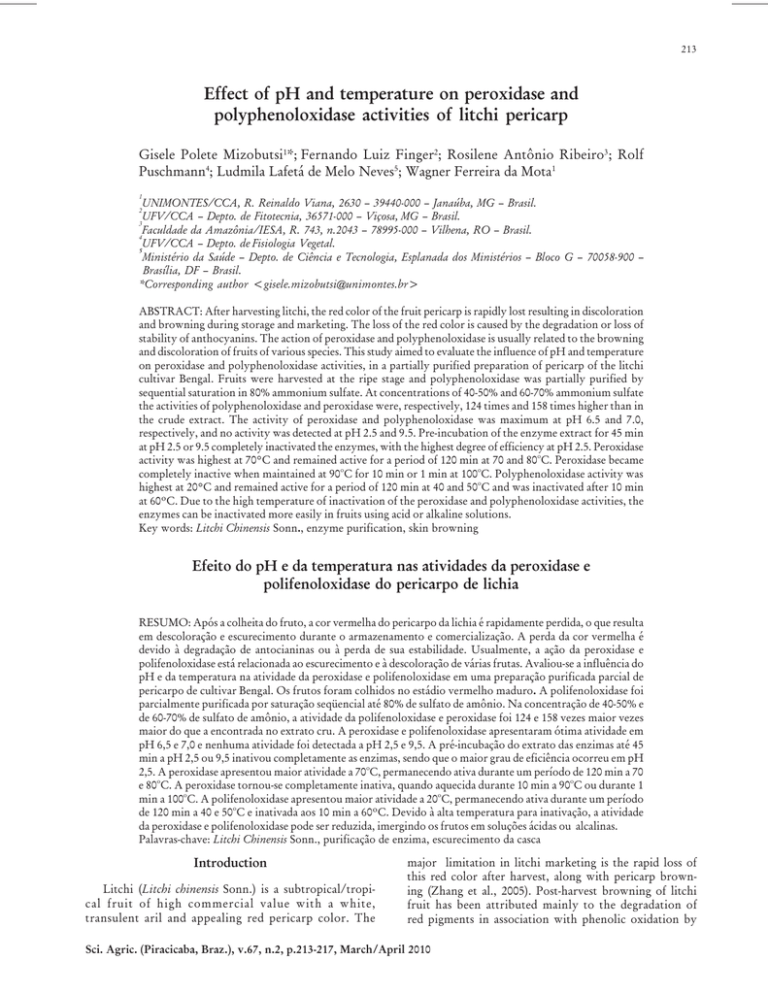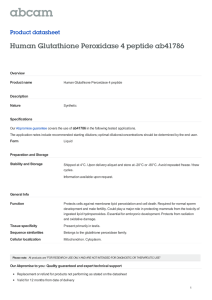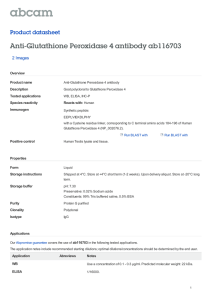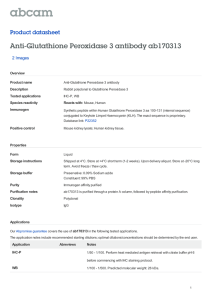Effect of pH and temperature on peroxidase and
advertisement

Peroxidase and polyphenoloxidase activities of litchi pericarp 213 Effect of pH and temperature on peroxidase and polyphenoloxidase activities of litchi pericarp Gisele Polete Mizobutsi1*; Fernando Luiz Finger2; Rosilene Antônio Ribeiro3; Rolf Puschmann4; Ludmila Lafetá de Melo Neves5; Wagner Ferreira da Mota1 1 UNIMONTES/CCA, R. Reinaldo Viana, 2630 – 39440-000 – Janaúba, MG – Brasil. UFV/CCA – Depto. de Fitotecnia, 36571-000 – Viçosa, MG – Brasil. 3 Faculdade da Amazônia/IESA, R. 743, n.2043 – 78995-000 – Vilhena, RO – Brasil. 4 UFV/CCA – Depto. de Fisiologia Vegetal. 5 Ministério da Saúde – Depto. de Ciência e Tecnologia, Esplanada dos Ministérios – Bloco G – 70058-900 – Brasília, DF – Brasil. *Corresponding author <gisele.mizobutsi@unimontes.br> 2 ABSTRACT: After harvesting litchi, the red color of the fruit pericarp is rapidly lost resulting in discoloration and browning during storage and marketing. The loss of the red color is caused by the degradation or loss of stability of anthocyanins. The action of peroxidase and polyphenoloxidase is usually related to the browning and discoloration of fruits of various species. This study aimed to evaluate the influence of pH and temperature on peroxidase and polyphenoloxidase activities, in a partially purified preparation of pericarp of the litchi cultivar Bengal. Fruits were harvested at the ripe stage and polyphenoloxidase was partially purified by sequential saturation in 80% ammonium sulfate. At concentrations of 40-50% and 60-70% ammonium sulfate the activities of polyphenoloxidase and peroxidase were, respectively, 124 times and 158 times higher than in the crude extract. The activity of peroxidase and polyphenoloxidase was maximum at pH 6.5 and 7.0, respectively, and no activity was detected at pH 2.5 and 9.5. Pre-incubation of the enzyme extract for 45 min at pH 2.5 or 9.5 completely inactivated the enzymes, with the highest degree of efficiency at pH 2.5. Peroxidase activity was highest at 70°C and remained active for a period of 120 min at 70 and 80oC. Peroxidase became completely inactive when maintained at 90oC for 10 min or 1 min at 100oC. Polyphenoloxidase activity was highest at 20°C and remained active for a period of 120 min at 40 and 50oC and was inactivated after 10 min at 60ºC. Due to the high temperature of inactivation of the peroxidase and polyphenoloxidase activities, the enzymes can be inactivated more easily in fruits using acid or alkaline solutions. Key words: Litchi Chinensis Sonn., enzyme purification, skin browning Efeito do pH e da temperatura nas atividades da peroxidase e polifenoloxidase do pericarpo de lichia RESUMO: Após a colheita do fruto, a cor vermelha do pericarpo da lichia é rapidamente perdida, o que resulta em descoloração e escurecimento durante o armazenamento e comercialização. A perda da cor vermelha é devido à degradação de antocianinas ou à perda de sua estabilidade. Usualmente, a ação da peroxidase e polifenoloxidase está relacionada ao escurecimento e à descoloração de várias frutas. Avaliou-se a influência do pH e da temperatura na atividade da peroxidase e polifenoloxidase em uma preparação purificada parcial de pericarpo de cultivar Bengal. Os frutos foram colhidos no estádio vermelho maduro. A polifenoloxidase foi parcialmente purificada por saturação seqüencial até 80% de sulfato de amônio. Na concentração de 40-50% e de 60-70% de sulfato de amônio, a atividade da polifenoloxidase e peroxidase foi 124 e 158 vezes maior vezes maior do que a encontrada no extrato cru. A peroxidase e polifenoloxidase apresentaram ótima atividade em pH 6,5 e 7,0 e nenhuma atividade foi detectada a pH 2,5 e 9,5. A pré-incubação do extrato das enzimas até 45 min a pH 2,5 ou 9,5 inativou completamente as enzimas, sendo que o maior grau de eficiência ocorreu em pH 2,5. A peroxidase apresentou maior atividade a 70oC, permanecendo ativa durante um período de 120 min a 70 e 80oC. A peroxidase tornou-se completamente inativa, quando aquecida durante 10 min a 90oC ou durante 1 min a 100oC. A polifenoloxidase apresentou maior atividade a 20oC, permanecendo ativa durante um período de 120 min a 40 e 50oC e inativada aos 10 min a 60ºC. Devido à alta temperatura para inativação, a atividade da peroxidase e polifenoloxidase pode ser reduzida, imergindo os frutos em soluções ácidas ou alcalinas. Palavras-chave: Litchi Chinensis Sonn., purificação de enzima, escurecimento da casca Introduction Litchi (Litchi chinensis Sonn.) is a subtropical/tropical fruit of high commercial value with a white, transulent aril and appealing red pericarp color. The major limitation in litchi marketing is the rapid loss of this red color after harvest, along with pericarp browning (Zhang et al., 2005). Post-harvest browning of litchi fruit has been attributed mainly to the degradation of red pigments in association with phenolic oxidation by Sci. Agric. (Piracicaba, Braz.), v.67, n.2, p.213-217, March/April 2010 214 Mizobutsi et al. polyphenoloxidase (PPO) and/or peroxidase (PO) enzymes (Jiang et al., 2004). Polyphenoloxidase (Liu et al., 2007) is a widely distributed copper-containing enzyme that catalyzes the hydroxylation of monophenols to odiphenols (EC 1.14.18.1, cresolase or monophenol monooxygenase) and the oxidation of o-diphenol to oquinones (EC 1.10.3.2, diphenolase or catecholase) and PO (EC 1.11.1.7) Li and Yan (1963) first detected the relationship between PPO activity and litchi peel browning. Significant progress in purification and characterization of PO and PPO and its substrates in litchi pericarp tissue has since been made. Nonetheless, enzymatic browning is still the major practical limitation of litchi fruit storage (Jiang et al., 2003). The purpose of this study was to investigate the influence of pH and temperature on peroxidase and polyphenoloxidase activity and the enzyme inactivation by pH and heat. icebath (cooling to 4oC) for 30 min and the remaining activity was determined at 25oC. Effect of pH on PPO and PO activities and stabilities The enzyme activity was measured by mixing dialyzed extract with 0.1 M sodium citrate-NaOH pH 2.5 6.0, 0.1 M phosphate buffer-NaOH pH 6.5 - 8.0 and 0.1 M Tris-HCl pH 8.5 - 9.5 buffers (Yue-Ming et al., 1997). The extract was pre-incubated with buffers of 0.2 M sodium citrate-NaOH pH 2.5 and 0.2 M Tris-HCl pH 9.5, at 1:1 (v/v) at 4oC, and the activity measured in 0.1 M phosphate buffer-NaOH pH 6.5 at 25oC, measured every 2.5 min of incubation, using guaiacol (24 mM) and hydrogen peroxide (60 mM) as substrate of peroxidase and 4-methylcatechol (100 mM) for polyphenoloxidase. Each experiment was replicated four times and the total protein of the extracts estimated by the method of Bradford (1976), using Bovine serum albumin (BSA) as standard. Material and Methods Extraction of PPO and PO Sixty grams of litchi pericarp were ground with 300 mL of cold 0.1 M phosphate buffer (pH 6.5), 0.1% sodium bisulfite, 150 mM NaCl for PO extraction and added to 1% polyvinylpyrrolidone (PVP) soluble in PPO for its extraction. The mixture was filtered through four layers of cheesecloth and centrifuged at 18,000g for 30 min at 4oC. The supernatant was saturated up to 80% ammonium sulfate in 20% steps for 30 min with agitation, followed by centrifugation at 18,000g for 30 min. The pellets were re-suspended in 10 mM phosphateNaOH, 0.1% sodium bisulfate pH 6.5 buffer and dialyzed overnight against the same buffer (Underhill and Critchley, 1995). All procedures were performed at 4oC. Enzyme Assay for PPO and PO Peroxidase activity in the extracts was measured as described by Loukili et al. (1999) using 24 mM guaiacol and 60 mM hydrogen peroxide in a spectrophotometer, recording changes in absorbance (470 nm). Polyphenoloxidase activity in the extracts was measured as proposed by Shin et al. (1997) in a spectrophotometer as well, recording the changes in absorbance (410 nm), using 100 mM 4-methylcatechol as substrate and 0.2 M phosphate buffer pH 6.5. Optimum temperature for PPO and PO activities The activity of peroxidase and polyphenoloxidase was determined in a temperature range from 10 oC to 100oC, at intervals of 10oC, after 10 min of pre-incubation in 0.2 M phosphate buffer, pH 6.5. The enzyme preparation was incubated at 70, 80, 90, and 100 oC for a period of two hours and aliquots of the material were taken every 10 min. Then the extract was placed in an Based on the information about the influence of pH and temperature on in vitro activity of PO and PPO, it is possible to inactivate these enzymes by using acidic or basic solutions and heat treatment, in order to increase the fruit storage period. Peroxidase began to precipitate when at least 30% ammonium sulfate was added, reaching the highest specific activity in a range of 60 to 70% saturation, which was 158 times higher than in the crude extract (Table 1). Purification procedures with ammonium sulfate usually induce two to four-fold increases of most enzymes. For litchi however, the gain in specific activity was much higher. This may indicate the presence of inhibitors in the crude extract of the litchi pericarp, which had been removed by the precipitation followed by dialysis. Peroxidase activity was pH-dependent, with complete inactivation at pH 2.5 and when ≥ 8.5 (Figure 1). The maximum enzyme activity observed at pH 6.5 decreased when the pH was reduced or increased; the drop was sharper in the alkaline than in the acid range (Figure 1). Maximum activity of litchi peroxidase was observed at a slightly acid pH, near pH 6 as observed for 210 180 AU/min/mg protein Plant Material Ripe red litchi fruits of cv. Bengal were harvested in Viçosa, MG, Brazil (lat 20º 54' S, long 42º 51' W, 650 m asl). The pericarp was removed and the fruits were stored in liquid nitrogen at -196oC until analysis. Results and Discussion 150 120 90 60 30 0 2.5 3.5 4.5 5.5 6.5 7.5 8.5 9.5 pH Figure 1 - Influence of pH on peroxidase activity in the pericarp of litchi fruit. Vertical error bars indicate standard deviation. Sci. Agric. (Piracicaba, Braz.), v.67, n.2, p.213-217, March/April 2010 215 Peroxidase and polyphenoloxidase activities of litchi pericarp Table 1 - Activity of litchi pericarp peroxidase and polyphenoloxidase in crude extract and after fractionation with ammonium sulfate. Ammonium sulfate saturation Polyphenoloxidase activity Peroxidase activity AU/min/mg protein AU/min/mg protein % Cr ude extract 0. 93 0. 73 0-10 1. 56 0 10-20 25. 63 0 20-30 52. 37 0 30-40 76. 94 4. 60 40-50 114. 61* 20. 02 50-60 80. 93 58. 27 60-70 53. 86 115. 10* 70-80 34. 59 109. 23 Fraction used for the pH and temperature experiments. AU: absorbance units. * 180 160 200 140 AU/min/mg protein AU/min/mg protein 250 150 100 50 120 100 80 60 40 20 0 0 5 10 15 20 25 30 35 40 45 0 Time (minutes) strawberry peroxidase (Civello et al., 1995). Pre-incubation of the extract at pH 2.5 or 9.5 caused a reduction in peroxidase activity, which was proportional to the period for which the extract had been maintained at low or high pH (Figure 2). The pH of 2.5 was more efficient in reducing peroxidase activity than 9.5; after 45 min of incubation the pH of 2.5 reduced the activity by 91.9% and the pH of 9.5 by 69.4% (Figure 2). These results show that peroxidase activity is more effectively inhibited in an acid than in an alkaline pH. From 10 to 30 oC the peroxidase activity increased slowly, at temperatures above 30oC the rate of activity increase was higher, and at 70oC the activity reached its peak (Figure 3). When the temperature exceeded 70oC, the activity began to decline, and inactivation was observed at 90 and 100oC after 10 min of pre-incubation in phosphate buffer at pH 6.5 (Figure 3). In fact, the enzyme activity was completely inactivated after boiling the extract for one minute. Maintaining the extract for 10 min at 90oC also inactivated the peroxidase reaction completely (Figure 4) and temperatures of 70 and 80oC reduced it proportionally to the period of incubation. After 120 min at 70 and 80oC the peroxidase activity in the extract was reduced by 58.8 and 67.6%, respectively (Fig- 10 20 30 40 50 60 70 80 90 100 Temperature (°C) Figure 3 - Influence of temperature on peroxidase activity of litchi pericarp. Error bars indicate standard deviation. 400 AU/min/mg protein Figure 2 - Influence of pre-incubation at pH 2.5 () and 9.5 (z) on activity of litchi fruit peroxidase. Vertical error bars indicate standard deviation. 300 200 100 0 0 20 40 60 80 100 120 Time (minutes) Figure 4 - Activity of litchi pericarp peroxidase after preincubation at 70oC () , 80oC (z) and 90oC (S ). Vertical error bars indicate standard deviation. ure 4). These results confirm that litchi is highly heatresistant, similar to peroxidase of fresh asparagus (Rodrigo et al., 1996), suggesting that extensive heat treatments are needed to inactivate litchi peroxidase. Sci. Agric. (Piracicaba, Braz.), v.67, n.2, p.213-217, March/April 2010 216 Mizobutsi et al. Pre-incubating the extract at pH 2.5 or 9.5 for as long as 45 min caused a decrease in PPO measured at optimum pH 6.5 (Figure 6). A pH of 2.5 was more efficient in reducing enzyme activity than pH 9.5 after 45 min of pre-incubation, reducing the specific enzyme activity by 94.6 and 70.9%, respectively (Figure 6). Thus, the inactivation of litchi polyphenoloxidase can be easily achieved by lowering the pH. The polyphenoloxidase activity was highest at 20°C, and was continuously reduced by rising temperatures until complete inactivation at 60ºC. PPO remained active for a period of 120 min at 40 and 50oC and was inactivated after 10 min at 60ºC (Figure 7). Jiang (2001) found that litchi PPO had a remarkably high optimum temperature of 65oC and was stable in a broad range of temperatures, with little activity reduction after 30 min at 75oC, while at higher temperatures, the enzyme was inactivated. Liu et al. (2007) showed that the optimum temperature was 45oCand when exceeding 45oC the PPO activity decreased. The optimum temperature of 18oC of the litchi enzyme was similar to that of the Amasya apple PPO (Oktay et al., 1995), and rather different from the 35 and 50oC found for Anna apple and strawberry, respectively (Serradell et al., 2000). However, Yue-Ming et al. (1997) reported that the enzyme in litchi fruit cv. Mauritius has a remarkably high optimum temperature (70oC). These 35 30 AU/min/mg protein Polyphenoloxidase activity was present in all fractions of ammonium sulfate precipitation, reaching the highest specific activity at 40% and 50% saturation, where a 124-fold increase was observed in the activity as compared to the crude extract (Table 1). Both below and above 40 - 50% ammonium sulfate saturation, the specific activity was gradually reduced, indicating that a great portion of PPO was, in fact, precipitated at 40% and 50% ammonium sulfate (Table 1). The gain in specific PPO activity achieved by the ammonium sulfate precipitation was extremely high, which may indicate the presence of inhibitors of the enzyme activity in the crude extract of litchi pericarp, and that such inhibition factors were efficiently removed by precipitation and subsequent overnight dialysis. Polyphenoloxidase reached a plateau of maximal activity at pH 6.5 and 7.0, which decreased when the pH was reduced or elevated (Figure 5). A sharper decrease in the activity was observed when the pH was higher than 7.0 compared to a decrease to less than 6.5, and no activity was detected at pH 2.5 and 9.5 (Figure 5). Between pH 6.0 and 3.0, the PPO activity remained constant, but at a lower activity level than in the range of pH 6.5 - 7.0. Jiang (2001) found that the PPO activity in litchi was maximum at pH 6.8 with 4-methylcatecol, while below pH 4.0 no enzyme activity was detected. Sellés-Marchart et al. (2006) reported that differences in optimum pH for PPO activity depended on the plant sources, extraction methods, purity of the enzyme, buffers, and substrates. To investigate the pH stability of litchi pericarp PPO, Liu et al. 2007 incubated the enzyme in various buffer solutions ranging from pH 3.1 to 8.0 at 4oC, and the residual PPO activity was determined at given time intervals. Tukey’s test showed no significant change in the enzyme activity during the 15 days of storage at pH 6.0, 7.5, and 8.0, respectively, leading to the conclusion that PPO was stable in a pH range of 6.0-8.0. PPO activity in Amasya apple was highest at pH 7.0 and 9.0, on the substrates cathecol and 4-methylcathecol, respectively (Oktay et al., 1995). This variation in pH in relation to maximum activities of polyphenoloxidases showed the presence of different isozymes with distinctive kinetic properties. 20 15 10 5 0 0 5 10 15 20 30 35 40 45 Time (minutes) Figure 6 - Influence of pre-incubation at pH on polyphenoloxidase. Vertical error bars indicate standard deviation. 70 16 60 AU/min/mg protein 14 AU/min/mg protein 25 12 10 8 6 4 50 40 30 20 10 2 0 0 10 2.5 3.5 4.5 5.5 6.5 7.5 8.5 9.5 pH Figure 5 - Influence of pH on polyphenoloxidase of pericarp of litchi fruit. Error bars mean standard deviation. 20 30 40 50 60 Temperature (°C) Figure 7 - Influence of temperature on the activity of litchi fruit pericarp. Vertical error bars indicate standard deviation. Sci. Agric. (Piracicaba, Braz.), v.67, n.2, p.213-217, March/April 2010 Peroxidase and polyphenoloxidase activities of litchi pericarp Acknowledgements 18 16 The authors thank CAPES and CNPq for the scholarships. 14 AU/min/mg protein 217 12 References 10 8 6 4 2 0 0 20 40 60 80 100 120 Time (minutes) Figure 8 - Activity of litchi pericarp polyphenoloxidase after preincubation at 40oC () , 50oC (z) and 60oC (S ). Vertical error bars indicate standard deviation. results clearly demonstrate the sensitivity of litchi polyphenoloxidase to heat; the activity can therefore be controlled by inducing either low or high temperatures. Heating the extract to 40oC slowly reduced the enzymatic activity of PPO and after 120 min the remaining activity was 64.4% of the initial reaction rate (Figure 8). Maintaining the temperature at 50oC for two hours also affected the enzyme action more dramatically, reducing the activity to 20.4% of that determined at the beginning of the heat treatment, while a temperature of 60oC for 10 min reduced the enzyme activity to scarcely detectable (Figure 8). The high heat-sensitivity of the pericarp PPO indicates that the undesirable browning caused by enzyme action may be dramatically reduced by this treatment. However, as the browning seems to result from the combined action of peroxidase and polyphenoloxidase, the heat treatment would not be effective due to the high thermal stability of the former enzyme (Shin et al., 1997). Jiang (2001) stated that the application of heat treatment seems inappropriate for the control of fruit browning in view of the optimum temperature and thermal stability of litchi PPO.. Further research is required to evaluate how the immersion treatment in acid or alkaline solutions would influence the red fruit color during storage. Jiang (2001) reported that the absence of PPO activity below pH 4.0 could explain the delay in peel browning of acid-treated litchi fruit. Conclusions The activity of peroxidase and polyphenoloxidase was maximum between pH 6.5 and 7.0 and no activity was detected at pH 2.5 or 9.5. The peroxidase activity peak was observed at 70oC. The enzyme was inactivated completely when maintained for 10 min at 90oC or for one minute at 100oC. The polyphenoloxidase activity increased from 10 to 20oC, the enzyme was inactivated completely when maintained for 10 min at 60oC. The browning of litchi fruit can be controlled by applying acid or alkaline solution treatments. Bradford, M.M. 1976. A rapid and sensitive method for the quantification of microgram quantities of protein utilizing the principle of protein-dye binding. Analytical Biochemistry 72: 248-254. Civello, P.M.; Martínez, G.A.; ChaveS, A.R; Añón, M.C.. 1995. Peroxidase from strawberry fruit (Fragaria ananassa Duch.): partial purification and determination of some properties. Journal Agriculture Food Chemistry 43: 2596-2601. Jiang, Y. 2001. Properties of litchi polyphenol oxidase. International Symposium on Litchi & Longan, Guangzhou, China. Jiang, Y.M.; Yao, I. H.; Lichter, A.; Li, J.R. 2003. Postharvest biology and handling of litchi fruit. International Journal of Food Agriculture and Environment 2: 76-81. Jiang, Y.; Duan X.; Joyce, D.; Zhang, Z. LI, J. 2004. Advances in understanding of enzymatic browning in harvested litchi fruit. Food Chemistry 88: 443-446.. Li, M.Q.; Yan, J.L. 1963. Study on polyphenol oxidase of litchi fruit pericarp. Acta Botanica Sinica 11: 329-336. Loukili, A.; Limam, F.; Ayadi, A.; Boyer, N.; Ouelhazi, L. 1999. Purification and characterization of a neutral peroxidase induced by rubbing tomato internodes. Physiology Plantarum 105: 2431. Liu, L.; Cao, S.; Xie, B.; Sun, Z.; Li, X.; Miao, W. 2007. Characterization of polyphenol oxidase from litchi pericarp using (-) .epicatechin as substrate. Journal of Agricultural and Food Chemistry 55: 7140-7143. Oktay, M.; Küfrevioðlu, I.; Kocaçaliþkan, I.; Þakiroðlu, H.. 1995. Polyphenoloxidase from Amasya apple. Journal Food Science 60: 494-496. Rodrigo, C.; Rodrigo, M.; Alvarruiz, A.; Frígola, A. 1996. Thermal inactivation at high temperatures and regeneration of green asparagus peroxidase. Journal of Food Protection 59: 1065-1071. Sellés-Marchart,S.; Casado-Vela,J.; Bru-martinez, R. 2006. Isolation of a latent polyphenol oxidase from loquat fruit (Eriobotrya japonica Lindl.): Kinetic characterization and comparison with the active form. Archives of Biochemistry and Biophysics 446: 175-185. Serradell, M.A.; Rozenfeld, P.A.; Martínez, G.A.; Civello, P.M.; Chaves, A.R; Añón, M.C. 2000. Polyphenoloxidase activity from strawberry fruit (Fragaria × ananassa, Duch., cv Selva): characterization and partial purification. Journal of Science Food Agriculture 80: 1421-1427. Shin, R.; Froderman, T; Flurkey, W.H.. 1997. Isolation and characterization of a mung bean leaf polyphenol oxidase. Phytochemistry 45: 15-21. Underhill, S.J.R.; Critchley, C. 1995. Anthocyanin decolorisation and its role in lychee pericarp browing. Australian Journal of Experimental Agriculture 34: 115-122. Yue-Ming, J.; Zauberman; Fuchs, Y. 1997. Partial purification and some properties of polyphenol oxidase extracted from litchi fruit pericarp. Postharvest Biology and Technology 10: 221228. Zhang, Z.; Pang, X.; Xuewu, D.; Ji, Z.; Jiang, Y. 2005. Role of peroxidase in anthocyanin degradation in litchi pericarp. Food Chemistry 90: 47-52. Received June 20, 2008 Accepted July 27, 2009 Sci. Agric. (Piracicaba, Braz.), v.67, n.2, p.213-217, March/April 2010




![Anti-Thyroid Peroxidase antibody [1.B.10] ab31829 Product datasheet Overview Product name](http://s2.studylib.net/store/data/011964745_1-5f75fbef9c57765583cc9a2be1b15b4b-300x300.png)